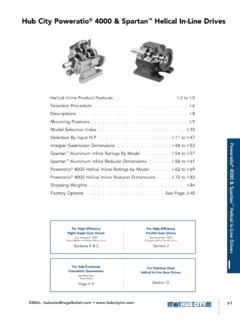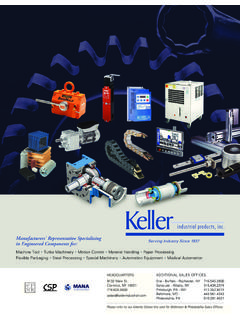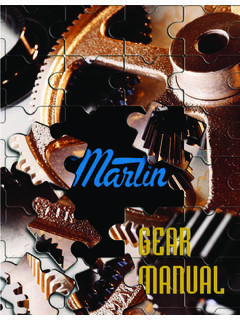Transcription of Zeiss Biotar 58mm f/2 Disassembly – Semi …
1 Zeiss Biotar 58mm f/2 Disassembly semi automatic Style for ExaktaAn adventure in lens repair by K. RhoadsThis is the story of Biotar 4427070, a lens with a troubled past, described on eBay as in good shape butcould probably use a professional cleaning. The release was stuck, the aperture blades were clean butbinding, the cocking mechanism would not reliably cock, the front assembly was not concentric with therear assembly, a ding in the focusing ring left wipe marks on the aperture ring, focusing was stiff and gritty,the bayonet tabs were bent, and there was fungus in the lens.
2 On eBay, that s what passes for good shape. The Biotar is described in various places as originating in 1911 or 1932, as a variant of a VoigtlanderPetzval design. It is also described as a 6-element double Gauss design. While I did not perform acomplete Disassembly , my guess is that this is a semi -symmetrical design: convex-plano objective,achromat doublet, aperture blades, achromat doublet, plano-convex rear Biotar is praised by Wrotniak as having a large following of photographers who describe its imagingas deeper, more three-dimensional, or simply better than that of most other lenses.
3 Indisputably, Biotar s imaging is slightly softer than Tessar s, while not degrading the perceived image sharpness, andthis may be the reason that so many photographers (including myself) like it a lot. ( )Part 1: The Focus & Release AssemblyRemove the release button with four screws. Can lubricate this unit without further Disassembly . Clean andthen graphite lube. Be sure the action is smooth, and to infinity, set to f/4, and mark the way the lens should rejoin before separating. Mark the position ofthe top of the focus barrel at infinity with a line on the aperture ring.
4 From the back of the lens, remove thethick spanner ring (thickest and furthest outside of the 3 visible spanner rings).If this spanner ring is too tight the auto aperture mechanism will bind and not close down, especially forwider apertures (may have to back off later). The lens will come apart into 2 main components, the lensassembly and the focus/release assembly. A spacer ring around the lens assembly is loose and can fall offthe assembly (an important item for attaining precise infinity focus later).
5 Observe the release/focusing assembly, with the inner helical ring in place. Note that the cockingmechanism moves a quarter circle (running from about 10 to 2 o clock in the above photo), then pops out apawl. On release the pawl pops back t perform the following separation if at all possible. To separate the release assembly from thefocusing assembly, remove the focus stop screw, a large black pan head screw inside and screw off thefocusing assembly by turning counterclockwise the helical drives up until it dethreads (when it isapproximately flush with the top of the focusing assembly), and then you continue unthreading the focusassembly from the release assembly.
6 So, two sets of threads were unscrewing, and then just one. Eventhough the helicals will rethread in many ways, those helicals must go back together with particular threadsmeshing with their matching grooves. You re in for hours of trouble trying to get the helicals back together,and timed correctly with the focusing you separated them anyway. Another spacer ring (silver side to front) will fall out of the focus assemblyif you invert it (likely also important for precise infinity focus later).
7 The shutter release assembly is stilloperational. Clean the mechanism and buff the aluminum at this point. Don t allow any protrusion to catchwhile buffing! Cleaning the cocking mechanism leaves it unlubricated and gritty feeling relube it withoutfurther Disassembly by forcing your lube (molykote) mentioned, the inner aluminum helical will (reverse) screw up and out when it gets flush to the top ofthe focusing ring. It can be painful getting it back together, so clean and lube it. After experimenting withMolykote and graphite I switched to Nyogel 701 which worked pretty well.
8 Probably should use NyoGelHelical 744 if I had it. The helical will screw back in (with effort and patience, and from the top, not thebottom). Note that the helical pushes out toward the front of the lens as you turn the lens to closerdistances. On reassembly, the rear of the focus assembly should almost hit its stop in the back of the releaseassembly. That s your best indication you got the appropriate meshing of the trick is to set the inner aluminum helicals at a certain point and then use the spanner wrench to hold theinner helical with its two grooves matching and meshing the upright posts on either side of the inside of therelease assembly, while you turn the outer focusing ring clockwise to screw the helicals on and down.
9 Youcan see the rigid posts (at 1 and 7 o clock) and the rotating aperture cocking post (at rest at 8 o clock) in thenext s the trick to reassemble the release and focus units: you have to reassemble the release unit and thefocusing unit WITHOUT the inner aluminum helical tube in place. Screw the focusing unit on all the way(clockwise) until it stops, and then unscrew it a scootch so the index mark matches infinity. Using this as areference point, unscrew the focusing ring one full turn plus a little (go past infinity to the meter mark,which is a point a little more than one full counterclockwise turn from your reference point).
10 Now drop thehelical tube into place, aligning its two grooves so they will mesh with the release unit s two alignmentposts, and keeping the aperture cocking post within visibility at all times (you can see a special cutout forits action at the bottom of the helical tube). The helicals are reverse threaded, so nudge them CCW. Juststart to screw the helical into place (a fraction of a turn, just where you hope it will start). Now place yourspanner wrench in the slots of the helical tube which accept the posts, and focus the focus ring down(clockwise).









